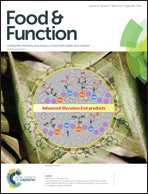Metabonomic analysis of quercetin against the toxicity of acrylamide in rat urine†
Abstract
This research aims to determine whether quercetin has protective effects against the toxicity of acrylamide (AA) using metabonomic technology. Randomly, the rats were assigned into a control group, AA treatment group, quercetin treatment group and quercetin plus AA treatment group. Quercetin and AA were administered to rats daily via gavage and drinking water for 16 weeks, respectively. To detect the metabonomic profiles of urine, ultra-performance liquid chromatography/mass spectrometry was used. A total of 15 metabolites, including biomarkers of AA exposure (GAMA, AAMA, and iso-AAMA) and quercetin exposure (quercetin and isorhamnetin), were identified. In comparison with the control group, the intensities of GAMA, AAMA, iso-AAMA, 1-salicylate glucuronide, vinylacetylglycine, PE(20:1(11Z)/14:0), 7-ketodeoxycholic acid, cysteic acid, p-cresol sulfate, and L-cysteine in the AA-treated group were statistically significantly increased (p < 0.01), and the intensities of 2-indolecarboxylic acid, 3-acetamidobutanal, and kynurenic acid in the AA-treated group were statistically significantly decreased (p < 0.01). The above-mentioned metabolites were significantly ameliorated in the quercetin (50 mg per kg bw) plus AA-treated group compared with the AA-treated group (p < 0.01 or p < 0.05). However, the intensities of these metabolites in the quercetin (50 mg per kg bw) plus AA-treated groups were still significantly different from those of the control group (p < 0.01 or p < 0.05). The above results suggest that quercetin has a partial protective effect on AA-induced toxicity. The protective effects include regulation of fatty acid metabolism and amino acid metabolism and enhancing the antioxidant defense system.



 Please wait while we load your content...
Please wait while we load your content...